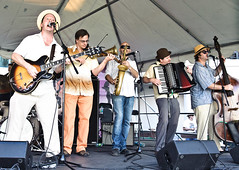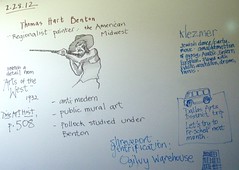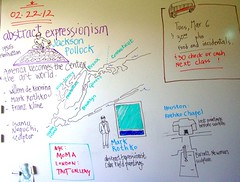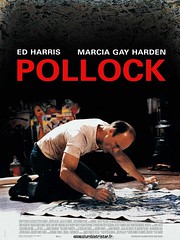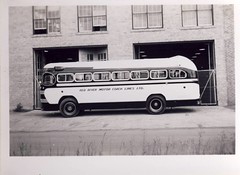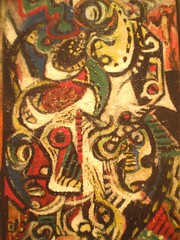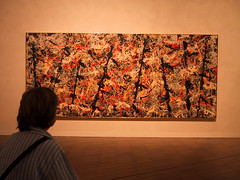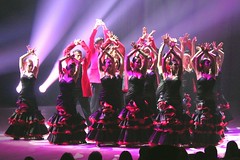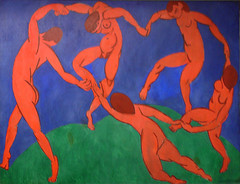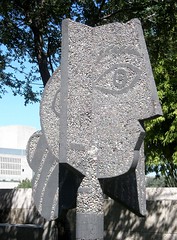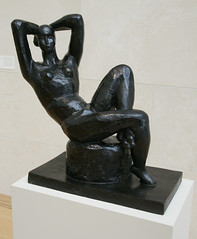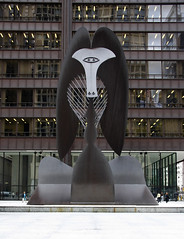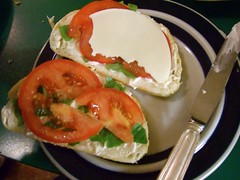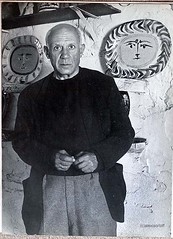Klezmer is a musical tradition of the Ashkenazic Jews of Eastern Europe, says Wikipedia.
Played by professional musicians called klezmorim, the genre originally consisted largely of dance tunes and instrumental display pieces for weddings and other celebrations.
In the United States the genre morphed as Yiddish-speaking Jewish immigrants from Eastern Europe, who arrived between 1880 and 1924,[1] met and assimilated American jazz.
Wednesday, February 29, 2012
Clasically American art: the murals and paintings of Thomas Hart Benton
Benton set the tone for American illustration in the 1920's and 30's. An example: the murals at La State Exhibit Museum are influenced by Benton.
An example of gentrification - "The old Ogilvie Hardware Building under the Spring and Market street viaducts in downtown Shreveport has been sold, with plans to convert it to loft-style apartments," says KTBS.com.
"The building, which was built in 1926 and is included in the National Register of Historic Places, has been vacant since 1999.
It's been bought by Provident Realty Advisors of Dallas. They plan to build 90 loft apartments, Downtown Development Authority director Liz Swaine said. Provident hopes to have the first apartments ready in January 2012.
Swaine said apartments will range in size from studios to two-bedroom, two-bath units. The average apartment size will be 800 square feet and the building will have a swimming pool, fitness center and business center, Swaine said.
The building can be seen as you come onto and off interstate exits into downtown Shreveport."
An example of gentrification - "The old Ogilvie Hardware Building under the Spring and Market street viaducts in downtown Shreveport has been sold, with plans to convert it to loft-style apartments," says KTBS.com.
"The building, which was built in 1926 and is included in the National Register of Historic Places, has been vacant since 1999.
It's been bought by Provident Realty Advisors of Dallas. They plan to build 90 loft apartments, Downtown Development Authority director Liz Swaine said. Provident hopes to have the first apartments ready in January 2012.
Swaine said apartments will range in size from studios to two-bedroom, two-bath units. The average apartment size will be 800 square feet and the building will have a swimming pool, fitness center and business center, Swaine said.
The building can be seen as you come onto and off interstate exits into downtown Shreveport."
Tuesday, February 28, 2012
The Arts of Life in America: Arts of the West / Thomas Hart Benton (1932)
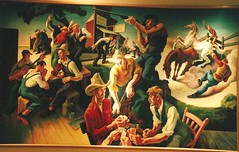
The Arts of Life in America: Arts of the West / Thomas Hart Benton (1932)
Originally uploaded by sftrajan
Along with Grant Wood and John Steuart Curry, he was at the forefront of the Regionalist art movement. His fluid, almost sculpted paintings showed everyday scenes of life in the United States.
Though his work is strongly associated with the Midwest, he painted scores of works of New York City, where he lived for more than 20 years; Martha’s Vineyard, where he summered for much of his adult life; the American South; and the American West.
Benton taught at the Art Students League of New York from 1926 to 1935 and at the Kansas City Art Institute from 1935 to 1941. His most famous student, Jackson Pollock, whom he mentored in the Art Students League, would diverge from Benton's style and found the Abstract Expressionist movement. Pollock often said that Benton's traditional teachings gave him something to rebel against.
Part of Greenwich Village: Washington Square Park
The Greenwich Village quiz
1. Mark Rothko was a native a) NYC b) Poland c) Russia d) Israel.
2. Which came first in the world of fine arts painting? a) impressionism b) expressionism
3. NYC replaced Paris as the center for cutting edge art in what decade?
a) 1940's b) 1950's c) 1960's d) 1970's.
4. The A bomb and the Cold War: which nation was second in demonstrating their possession of the nuclear bomb? a) US b) Russia c) England d) Germany
5. Two of NYC's boroughs are on Long Island: a) Bronx, Brooklyn b) Brooklyn, Manhattan c) Queens, Brooklyn d) Bronx, Manhattan.
6. "Color field paintings:" a) Pollock b) Rothko c) Benton
7. Houston is the site of the outstanding Menil Collection and the nearby __ Chapel. a) Rothko b) Pollock c) Matisse d) Magritte.
8. "To whom shall I hire myself out? What beast must I adore? What holy image is attacked? What hearts must I break? What lie must I maintain? What blood tread?"
It is a quote from the 19th century French poet Artur Rimbaud used by a) Jackson Pollock b) Lee Krasner c) Peggy Guggenheim d) Mark Rothko.
9. "La danse," Dance, is an epic painting composed in 1909 by the French painter a) Pablo Picasso b) Vincent Van Gogh c) Henri Matisse d) Paul Cezanne.
10. Greenwich Village in the 1950's: a) walkups and lofts b) gentrification.
11. In Dallas you will find work by Picasso in 2 of the 3 museums in the Dallas Arts District. You will not find Picasso in the a) Nasher b) DMA c) Crow d) Meyerson.
12. A perquisite, or "perk," for government work in the early 1940's was
a) draft deferment b) 4-F draft status c) salary adequate to feed a family d) free housing.
13. In one or 2 sentences explain the quote in number 8.
1. Mark Rothko was a native a) NYC b) Poland c) Russia d) Israel.
2. Which came first in the world of fine arts painting? a) impressionism b) expressionism
3. NYC replaced Paris as the center for cutting edge art in what decade?
a) 1940's b) 1950's c) 1960's d) 1970's.
4. The A bomb and the Cold War: which nation was second in demonstrating their possession of the nuclear bomb? a) US b) Russia c) England d) Germany
5. Two of NYC's boroughs are on Long Island: a) Bronx, Brooklyn b) Brooklyn, Manhattan c) Queens, Brooklyn d) Bronx, Manhattan.
6. "Color field paintings:" a) Pollock b) Rothko c) Benton
7. Houston is the site of the outstanding Menil Collection and the nearby __ Chapel. a) Rothko b) Pollock c) Matisse d) Magritte.
8. "To whom shall I hire myself out? What beast must I adore? What holy image is attacked? What hearts must I break? What lie must I maintain? What blood tread?"
It is a quote from the 19th century French poet Artur Rimbaud used by a) Jackson Pollock b) Lee Krasner c) Peggy Guggenheim d) Mark Rothko.
9. "La danse," Dance, is an epic painting composed in 1909 by the French painter a) Pablo Picasso b) Vincent Van Gogh c) Henri Matisse d) Paul Cezanne.
10. Greenwich Village in the 1950's: a) walkups and lofts b) gentrification.
11. In Dallas you will find work by Picasso in 2 of the 3 museums in the Dallas Arts District. You will not find Picasso in the a) Nasher b) DMA c) Crow d) Meyerson.
12. A perquisite, or "perk," for government work in the early 1940's was
a) draft deferment b) 4-F draft status c) salary adequate to feed a family d) free housing.
13. In one or 2 sentences explain the quote in number 8.
The Oscar-winning movie "Pollock"
At the end of the 1940's, abstract expressionist Jackson Pollock (1912-1956) is featured in Life magazine.
Flashback to 1941, he's living with his brother in a tiny apartment in New York City, drinking too much, and exhibiting an occasional painting in group shows. That's when he meets artist Lee Krasner, who puts her career on hold to be his companion, lover, champion, wife, and, in essence, caretaker.
To get him away from booze, insecurity, and the stress of city life, they move to the Hamptons where nature and sobriety help Pollock achieve a breakthrough in style: a critic praises, then Life magazine calls.
But so do old demons: the end is nasty, brutish, and short. Written by
Quotes:
To whom shall I hire myself out?
What beast must I adore?
What holy image is attacked?
What hearts must I break?
What lie must I maintain?
What blood tread?
— Arthur Rimbaud, French poet (1854-1891) Used by Krasner.
Lee Krasner: You're not just randomly putting paint on the canvas, you're painting *something*. You can't abstract from nothing, you can only abstract from life, from nature.
Jackson Pollock: I *am* nature.
Much of the fascination of the film lies in the examination of the complexities of the almost love-hate relationship that develops between the two. On the one hand, we sense that Jackson and Lee provide just the right emotional complement for one another – a symbiosis which lays the foundation for an environment in which Pollock's creativity and artistic experimentation can expand and flourish.
- symbiosis
Flashback to 1941, he's living with his brother in a tiny apartment in New York City, drinking too much, and exhibiting an occasional painting in group shows. That's when he meets artist Lee Krasner, who puts her career on hold to be his companion, lover, champion, wife, and, in essence, caretaker.
To get him away from booze, insecurity, and the stress of city life, they move to the Hamptons where nature and sobriety help Pollock achieve a breakthrough in style: a critic praises, then Life magazine calls.
But so do old demons: the end is nasty, brutish, and short. Written by
Quotes:
To whom shall I hire myself out?
What beast must I adore?
What holy image is attacked?
What hearts must I break?
What lie must I maintain?
What blood tread?
— Arthur Rimbaud, French poet (1854-1891) Used by Krasner.
Lee Krasner: You're not just randomly putting paint on the canvas, you're painting *something*. You can't abstract from nothing, you can only abstract from life, from nature.
Jackson Pollock: I *am* nature.
Much of the fascination of the film lies in the examination of the complexities of the almost love-hate relationship that develops between the two. On the one hand, we sense that Jackson and Lee provide just the right emotional complement for one another – a symbiosis which lays the foundation for an environment in which Pollock's creativity and artistic experimentation can expand and flourish.
- symbiosis
Thursday, February 23, 2012
Delayed: Field trip to Dallas Arts District: $40 each for busfare
DElayed! Only about 20 students have indicated willingness to go on Mar 6 so I have decided to delay the trip and try again in a month. Red River Coaches price for 40-seat bus will be $40 per student.
Load at 6 am, Magnet, return about 8 pm.
Please also plan on packing a breakfast.
About $6 - 8 for lunch from a food truck.
Fast food supper: $6.
Incidentals, such as a museum gift shop item??
Am inviting students who were in fine arts in previous years to fill out the 40 seats.
Load at 6 am, Magnet, return about 8 pm.
Please also plan on packing a breakfast.
About $6 - 8 for lunch from a food truck.
Fast food supper: $6.
Incidentals, such as a museum gift shop item??
Am inviting students who were in fine arts in previous years to fill out the 40 seats.
Tuesday, February 21, 2012
Jackson Pollock, 1938: 'Masqued Image'
Paul Jackson Pollock (1912 – 1956) was an influential American painter and a major figure in the abstract expressionist movement. He was well known for his uniquely defined style of drip painting.
During his lifetime, Pollock enjoyed considerable fame and notoriety. He was regarded as a mostly reclusive artist. He had a volatile personality, and struggled with alcoholism for most of his life. In 1945, he married the artist Lee Krasner, who became an important influence on his career and on his legacy.[4]
Pollock died at the age of 44 in an alcohol-related car accident. In December 1956, the year of his death, he was given a memorial retrospective exhibition at the Museum of Modern Art (MoMA) in New York City, and a larger more comprehensive exhibition there in 1967. More recently, in 1998 and 1999, his work was honored with large-scale retrospective exhibitions at MoMA and at The Tate in London.[5][6]
In 2000, Pollock was the subject of an Academy Award–winning film Pollock directed by and starring Ed Harris.
During his lifetime, Pollock enjoyed considerable fame and notoriety. He was regarded as a mostly reclusive artist. He had a volatile personality, and struggled with alcoholism for most of his life. In 1945, he married the artist Lee Krasner, who became an important influence on his career and on his legacy.[4]
Pollock died at the age of 44 in an alcohol-related car accident. In December 1956, the year of his death, he was given a memorial retrospective exhibition at the Museum of Modern Art (MoMA) in New York City, and a larger more comprehensive exhibition there in 1967. More recently, in 1998 and 1999, his work was honored with large-scale retrospective exhibitions at MoMA and at The Tate in London.[5][6]
In 2000, Pollock was the subject of an Academy Award–winning film Pollock directed by and starring Ed Harris.
Blue Poles: Jackson Pollock, 1952
Blue Poles is an abstract painting from 1952 by the American artist Jackson Pollock. It is more properly known as Blue Poles: Number 11, 1952, says Wikipedia.
In 1973, the work was purchased by the Australian government for the National Gallery of Australia for US$2 million. At the time, this was the highest price ever paid for a modern painting. In the conservative climate of the time, the purchase created a political and media scandal.
The painting is now one of the most popular exhibits in the gallery, and now is thought to be worth as much as $200 million.
In 1973, the work was purchased by the Australian government for the National Gallery of Australia for US$2 million. At the time, this was the highest price ever paid for a modern painting. In the conservative climate of the time, the purchase created a political and media scandal.
The painting is now one of the most popular exhibits in the gallery, and now is thought to be worth as much as $200 million.
Jackson Pollock's "Greyed Rainbow"
The Pollock quiz
1. Cheap housing can be had by struggling painters in the 1940's in Manhattan's __.
a) West Side b) Chelsea c) SoHo d) Lower East Side.
2. A perquisite, or "perk," for government work in the 1940's was a) draft deferment b) 4-F draft status c) salary adequate to feed a family d) free housing.
3. The state that is immediately northeast of New York: a) New Jersey b) Connecticut c) Delaware d) Massachusetts.
4. Pollock's almost-as-famous wife, also a modernist painter, was a) Peggy Guggenheim b) Marilyn Monroe c) Frida Kahlo d) Lee Krasner.
5. Pollock's principal patron was a) Peggy Guggenheim b) Marilyn Monroe c) Frida Kahlo d) Lee Krasner.
6. The school of art to which Pollock and his peers were attached by the media:
___ expressionism. a) Surrealist b) Abstract c) Modernist d) Dadaist.
7. American magazine with emphasis on photojournalism; it dominated the market from the 40's through the 70's: a) Fortune b) Look c) Life d) Saturday Evening Post.
8. American illustrator whose realistic work represented the values of Middle America:
a) Norman Rockwell b) Thomas Hart Benton c) Marcel Duchamp d) Henry Luce.
9. T / F According to the movie Pollock the NY Times art critic wrote overwhelmingly positive reviews of his shows.
10. Pollock and Krasner have a productive period when they moved out of Manhattan. They relocated to a) Connecticut b) New Jersey c) Martha's Vineyard Island d) Long Island.
11. Successful artist of Pollock's NYC circle a) Pablo Picasso b) Willem de Kooning c) Andy Warhol d) Keith Haring.
12. The person who offered this literary quote: "To whom shall I hire myself out? / What beast must I adore? / What holy image is attacked? / What hearts must I break? / What lie must I maintain? / And, what blood shed?" a) Jackson Pollock
b) Lee Krasner c) Peggy Guggenheim d) Sande Pollock (the brother).
1. Cheap housing can be had by struggling painters in the 1940's in Manhattan's __.
a) West Side b) Chelsea c) SoHo d) Lower East Side.
2. A perquisite, or "perk," for government work in the 1940's was a) draft deferment b) 4-F draft status c) salary adequate to feed a family d) free housing.
3. The state that is immediately northeast of New York: a) New Jersey b) Connecticut c) Delaware d) Massachusetts.
4. Pollock's almost-as-famous wife, also a modernist painter, was a) Peggy Guggenheim b) Marilyn Monroe c) Frida Kahlo d) Lee Krasner.
5. Pollock's principal patron was a) Peggy Guggenheim b) Marilyn Monroe c) Frida Kahlo d) Lee Krasner.
6. The school of art to which Pollock and his peers were attached by the media:
___ expressionism. a) Surrealist b) Abstract c) Modernist d) Dadaist.
7. American magazine with emphasis on photojournalism; it dominated the market from the 40's through the 70's: a) Fortune b) Look c) Life d) Saturday Evening Post.
8. American illustrator whose realistic work represented the values of Middle America:
a) Norman Rockwell b) Thomas Hart Benton c) Marcel Duchamp d) Henry Luce.
9. T / F According to the movie Pollock the NY Times art critic wrote overwhelmingly positive reviews of his shows.
10. Pollock and Krasner have a productive period when they moved out of Manhattan. They relocated to a) Connecticut b) New Jersey c) Martha's Vineyard Island d) Long Island.
11. Successful artist of Pollock's NYC circle a) Pablo Picasso b) Willem de Kooning c) Andy Warhol d) Keith Haring.
12. The person who offered this literary quote: "To whom shall I hire myself out? / What beast must I adore? / What holy image is attacked? / What hearts must I break? / What lie must I maintain? / And, what blood shed?" a) Jackson Pollock
b) Lee Krasner c) Peggy Guggenheim d) Sande Pollock (the brother).
Thursday, February 16, 2012
Henri Matisse: a series called Les Nus de Dos, or The Backs
Bronze bas reliefs created by Matisse between 1909 and 1930.
These are displayed at UCLA.
These are displayed at UCLA.
Wednesday, February 15, 2012
Maurice Ravel's classic 18-minute 1928 concerto: "Bolero"
Joseph-Maurice Ravel (1875 – 1937) was a French composer known especially for his melodies, orchestral and instrumental textures and effects, says Wikipedia.
In 1928 Ravel composed his most famous and controversial orchestral work, Boléro, originally called Fandango. Ravel called it “an experiment in a very special and limited direction”.[77] He stated his idea for the piece, “I am going to try to repeat it a number of times on different orchestral levels but without any development.”[78] He conceived of it as an accompaniment to a ballet and not as an orchestral piece as, in his own opinion, “it has no music in it”, and was somewhat taken aback by its popular success.[78]
Please see Youtube for recordings.
In 1928 Ravel composed his most famous and controversial orchestral work, Boléro, originally called Fandango. Ravel called it “an experiment in a very special and limited direction”.[77] He stated his idea for the piece, “I am going to try to repeat it a number of times on different orchestral levels but without any development.”[78] He conceived of it as an accompaniment to a ballet and not as an orchestral piece as, in his own opinion, “it has no music in it”, and was somewhat taken aback by its popular success.[78]
Please see Youtube for recordings.
La Danse, Henri Matisse
La Danse, or Dance, is commonly recognized as "a key point of (Matisse's) career and in the development of modern painting".[5] It resides in the Hermitage Museum in St. Petersburg.
La Danse is a large decorative panel, painted with a companion piece, Music, specifically for the Russian businessman and art collector Sergei Shchukin, with whom Matisse had a long association. Until the October Revolution of 1917, this painting hung together with Music on the staircase of Shchukin's Moscow mansion, says Wikipedia.[4]
The painting shows five dancing figures, painted in a strong red, set against a very simplified green landscape and deep blue sky. It reflects Matisse's incipient fascination with primitive art, and uses a classic Fauvist color palette: the intense warm colors against the cool blue-green background and the rhythmical succession of dancing nudes convey the feelings of emotional liberation and hedonism. The painting is often associated with the "Dance of the Young Girls" from Igor Stravinsky's famous musical work The Rite of Spring.
La Danse is a large decorative panel, painted with a companion piece, Music, specifically for the Russian businessman and art collector Sergei Shchukin, with whom Matisse had a long association. Until the October Revolution of 1917, this painting hung together with Music on the staircase of Shchukin's Moscow mansion, says Wikipedia.[4]
The painting shows five dancing figures, painted in a strong red, set against a very simplified green landscape and deep blue sky. It reflects Matisse's incipient fascination with primitive art, and uses a classic Fauvist color palette: the intense warm colors against the cool blue-green background and the rhythmical succession of dancing nudes convey the feelings of emotional liberation and hedonism. The painting is often associated with the "Dance of the Young Girls" from Igor Stravinsky's famous musical work The Rite of Spring.
Monday, February 13, 2012
Overviews of Nasher Sculpture Center, Dallas Museum of Art and Crow Collection of Asian Art
Create an overview of the 3 Dallas art centers to be visited by Fine Arts students on Tues, mar 6.
DMA, Nasher and Crow
- Brief description.
- Historic artists included.
- 2 images each.
12 pts
Due Fri as presentation.
DMA, Nasher and Crow
- Brief description.
- Historic artists included.
- 2 images each.
12 pts
Due Fri as presentation.
Visual project: Matisse and Picasso via 10 images
Use 10 of the most famous images for Matisse and Picasso in comparing their careers.
Include a paragraph that summarizes their significance.
Due in digital form so that it can ne presented in projection next class - Wed.
10 pts.
Include a paragraph that summarizes their significance.
Due in digital form so that it can ne presented in projection next class - Wed.
10 pts.
Big D: economic monster with a sparkling Arts District
Dallas is the third-largest city in the state of Texas[4][5] and the ninth-largest in the United States. The Dallas-Fort Worth Metroplex is the largest metropolitan area in the South and fourth-largest metropolitan area in the United States.[6][7][8]
The city is the largest economic center of the 12-county Dallas–Fort Worth–Arlington metropolitan area; it has a population of 6,371,773.[10]
The metroplex economy is the sixth largest in the United States, with a 2010 gross metropolitan product of $374 billion.[11]
Before Texas was claimed in the 18th century as a part of the Viceroyalty of New Spain by the Spanish Empire, the area was inhabited by the Caddo people.
Later, France also claimed the area, but in 1819 the Adams-Onís Treaty made the Red River the northern boundary of New Spain, officially placing the future location of Dallas well within Spanish territory.[16] The area remained under Spanish rule until 1821, when Mexico declared independence from Spain and the area became part of the Mexican state of Coahuila y Tejas.
In 1836, the Republic of Texas broke off from Mexico to become an independent nation.[17]
John Neely Bryan and his Arkansas friend Joe Dallas established a permanent settlement and called that settlement Dallas. The Republic of Texas was then annexed by the United States in 1845.
The Arts District in the northern section of Downtown includes the
- Dallas Museum of Art
- Morton H. Meyerson Symphony Center
- Trammell & Margaret Crow Collection of Asian Art
- Nasher Sculpture Center
- Dallas Contemporary, and The Dallas Children's Theater.
- Winspear Opera House
- Dee and Charles Wyly Theatre
- City Performance Hall.
- DISD's Booker T. Washington High School for the Performing and Visual Arts,
Deep Ellum, immediately east of Downtown, originally became popular during the 1920s and 1930s as the prime jazz and blues hot spot in the South.[44] Artists such as Blind Lemon Jefferson, Robert Johnson, Huddie "Leadbelly" Ledbetter, and Bessie Smith played in original Deep Ellum clubs such as The Harlem and The Palace.
Today, Deep Ellum is home to hundreds of artists who live in lofts and operate in studios throughout the district alongside bars, pubs, and concert venues.
The city is the largest economic center of the 12-county Dallas–Fort Worth–Arlington metropolitan area; it has a population of 6,371,773.[10]
The metroplex economy is the sixth largest in the United States, with a 2010 gross metropolitan product of $374 billion.[11]
Before Texas was claimed in the 18th century as a part of the Viceroyalty of New Spain by the Spanish Empire, the area was inhabited by the Caddo people.
Later, France also claimed the area, but in 1819 the Adams-Onís Treaty made the Red River the northern boundary of New Spain, officially placing the future location of Dallas well within Spanish territory.[16] The area remained under Spanish rule until 1821, when Mexico declared independence from Spain and the area became part of the Mexican state of Coahuila y Tejas.
In 1836, the Republic of Texas broke off from Mexico to become an independent nation.[17]
John Neely Bryan and his Arkansas friend Joe Dallas established a permanent settlement and called that settlement Dallas. The Republic of Texas was then annexed by the United States in 1845.
The Arts District in the northern section of Downtown includes the
- Dallas Museum of Art
- Morton H. Meyerson Symphony Center
- Trammell & Margaret Crow Collection of Asian Art
- Nasher Sculpture Center
- Dallas Contemporary, and The Dallas Children's Theater.
- Winspear Opera House
- Dee and Charles Wyly Theatre
- City Performance Hall.
- DISD's Booker T. Washington High School for the Performing and Visual Arts,
Deep Ellum, immediately east of Downtown, originally became popular during the 1920s and 1930s as the prime jazz and blues hot spot in the South.[44] Artists such as Blind Lemon Jefferson, Robert Johnson, Huddie "Leadbelly" Ledbetter, and Bessie Smith played in original Deep Ellum clubs such as The Harlem and The Palace.
Today, Deep Ellum is home to hundreds of artists who live in lofts and operate in studios throughout the district alongside bars, pubs, and concert venues.
Friday, February 10, 2012
All-day trek to Dallas Arts District: Tues, March 6, 6:00 am to 7:00 pm
Planning is underway for an all-day coach trip (Red River Coaches) to the Dallas Arts District.
- Begin with an 11 am tour in the Dallas Museum of Art (DMA).
- Across the street is the Nasher Sculpture Center, a splendid center of much more than sculpture.
- Across another street is the Crow Collection of Asian Art.
- Nearby we will find about 4 food trucks. You may pack a lunch from home or purchase a lunch from a food truck (probably about $10).
Tentative schedule:
- load bus at Magnet @ 6 am.
- fast food stop app half way to Dallas.
- tour DMA at 11 am
- follow with lunch break.
- visits to Nasher and Crow.
- 3 pm, board bus for trip home.
- fast food stop on road.
- arrive at Magnet about 7:00 pm.
- Parents are encouraged to accompany us! Probably you should plan to drive in a parent vehicle.
- Bus seats 56; I have some 60 students.
- Cost about $33 each for the bus, I think. About $17 for museums. About $20 for lunch and supper. Some will bring extra $ for shopping in the museum gift shops.
Thanks to Natalie Rambis and Madi Greer for aid in planning the trip!
- Begin with an 11 am tour in the Dallas Museum of Art (DMA).
- Across the street is the Nasher Sculpture Center, a splendid center of much more than sculpture.
- Across another street is the Crow Collection of Asian Art.
- Nearby we will find about 4 food trucks. You may pack a lunch from home or purchase a lunch from a food truck (probably about $10).
Tentative schedule:
- load bus at Magnet @ 6 am.
- fast food stop app half way to Dallas.
- tour DMA at 11 am
- follow with lunch break.
- visits to Nasher and Crow.
- 3 pm, board bus for trip home.
- fast food stop on road.
- arrive at Magnet about 7:00 pm.
- Parents are encouraged to accompany us! Probably you should plan to drive in a parent vehicle.
- Bus seats 56; I have some 60 students.
- Cost about $33 each for the bus, I think. About $17 for museums. About $20 for lunch and supper. Some will bring extra $ for shopping in the museum gift shops.
Thanks to Natalie Rambis and Madi Greer for aid in planning the trip!
Wednesday, February 8, 2012
"Rose is a rose is a rose is a rose:" author and art collector Gertrude Stein
Gertrude Stein (1874 – 1946) was an American writer, poet and art collector who spent most of her life in France.
Much of Gertrude Stein's fame derives from a private modern art gallery she assembled, from 1904 to 1913, with her brother Leo Stein. Carl Van Vechten (music critic for the New York Times and then drama critic for the New York Press), and Henry McBride (art critic for the New York Sun), did much to increase Stein's fame in the USA.
By early 1906, Leo and Gertrude Stein's studio had many paintings by Henri Manguin, Pierre Bonnard, Pablo Picasso, Paul Cézanne, Pierre-Auguste Renoir, Honoré Daumier, Henri Matisse, and Henri de Toulouse-Lautrec.[23]
During the 1920s, her salon at 27 Rue de Fleurus, with walls covered by avant-garde paintings, attracted many of the great writers of the time, including Ernest Hemingway, Ezra Pound, Thornton Wilder, and Sherwood Anderson. She has been credited with inventing the term "Lost Generation" for some of these expatriate American writers.
About her childhood home in Oakland, she famously said, "There is no there there."
Much of Gertrude Stein's fame derives from a private modern art gallery she assembled, from 1904 to 1913, with her brother Leo Stein. Carl Van Vechten (music critic for the New York Times and then drama critic for the New York Press), and Henry McBride (art critic for the New York Sun), did much to increase Stein's fame in the USA.
By early 1906, Leo and Gertrude Stein's studio had many paintings by Henri Manguin, Pierre Bonnard, Pablo Picasso, Paul Cézanne, Pierre-Auguste Renoir, Honoré Daumier, Henri Matisse, and Henri de Toulouse-Lautrec.[23]
During the 1920s, her salon at 27 Rue de Fleurus, with walls covered by avant-garde paintings, attracted many of the great writers of the time, including Ernest Hemingway, Ezra Pound, Thornton Wilder, and Sherwood Anderson. She has been credited with inventing the term "Lost Generation" for some of these expatriate American writers.
About her childhood home in Oakland, she famously said, "There is no there there."
Tuesday, February 7, 2012
The 50-foot, 162-ton sculpture called Chicago Picasso
The Chicago Picasso (often just The Picasso) is an untitled monumental sculpture by Pablo Picasso in Chicago, Illinois. The sculpture, dedicated in 1967 in Daley Plaza in the Chicago Loop, is 50 feet (15.2 m) tall and weighs 162 tons, says Wikipedia.[1]
The Cubist sculpture by Picasso was the first such major public artwork in Downtown Chicago, and has become a well known landmark.
It is known for its inviting jungle gym-like characteristics.[2] Visitors to Daley Plaza can often be seen climbing on and sliding down the base of the sculpture.
Picasso as offered payment of $100,000 but refused it, stating that he wanted to make a gift of his work.[4
The sculpture was initially met with controversy.Today, the Chicago Picasso has become a well known meeting spot for Chicagoans.
The Cubist sculpture by Picasso was the first such major public artwork in Downtown Chicago, and has become a well known landmark.
It is known for its inviting jungle gym-like characteristics.[2] Visitors to Daley Plaza can often be seen climbing on and sliding down the base of the sculpture.
Picasso as offered payment of $100,000 but refused it, stating that he wanted to make a gift of his work.[4
The sculpture was initially met with controversy.Today, the Chicago Picasso has become a well known meeting spot for Chicagoans.
Friday, February 3, 2012
Taste of the Mediterranean on Thurs
Paella, the national dish of Espana, got the class moving toward the Med Dish Day. Doctors say it's the healthiest cuisine.
Picasso vocab -
- mariscos
- prawn
- scampi
- calamari
- mussels
- arroz
- Metropolitain / 1900
- Montmartre
- Moulin Rouge
- bikini
- Sacre Coeur
- econ dev via the arts
- Alhambra
- arabesque / geometric or vine-like or calligraphy
- fountains / Arabia
- Dove & olive branch, 1949
- Dora Maar
- Francoise Gilot
- French Resistance
- Antibes, Cote d'Azur
- plywood and deck paint
Picasso vocab -
- mariscos
- prawn
- scampi
- calamari
- mussels
- arroz
- Metropolitain / 1900
- Montmartre
- Moulin Rouge
- bikini
- Sacre Coeur
- econ dev via the arts
- Alhambra
- arabesque / geometric or vine-like or calligraphy
- fountains / Arabia
- Dove & olive branch, 1949
- Dora Maar
- Francoise Gilot
- French Resistance
- Antibes, Cote d'Azur
- plywood and deck paint
Wednesday, February 1, 2012
Picasso review
1. Like Lennon & McCartney, Pablo Picasso was competitive with his
peers. He both worked with and in an effort to top fellows like:
a) Jackson Pollock b) Henri Matise c) Chuck Close d) Richard Serra.
2. Picasso would have served you a supper of a) tortellini b)
sauerkraut c) mughal curry d) paella.
3. The Spanish peninsula was occupied by the Romans and, later, by the
North African Moors. The peninsula is called a) Apulia b) Iberia
c) Anatolia d) Barcelona.
4. Seville, Cordova, Granada: these are the Moorish cities of Spain's
southern region. It is known as a) Andalusia b) Navarre c) Valencia d)
Aragon.
5. The region of Paris historically notable for pimps, eccentrics,
anarchists, students and artists: a) Bastille b) le Louvre c) Montmartre d) Champs Elysees.
6. In stage production the Harlequin is the hungry, lecherous and acrobatic
a) buffoon b) protagonist c) antagonist d) heroine.
7. Which order of production is correct? a) opium>morphine>heroin b)
heroin>opium>morphine c) morphine>opium>heroin.
8. Les Demoiselles d'Avignon were a group of young women in a brothel
in a) Madrid b) Paris c) Barcelona d) Malaga.
9. We can see that Picasso saw himself as a shaman, an intermediary
between the human and spirit worlds, by his display of influence from
a) surrealism b) cubism c) Africa d) mythology.
10. Chinese influence in Paris: a) Lapin Agile b) Les Deux Magots c)
Harlequins d) opium.
11. This figure dwelled at the heart of the Cretan labyrinth: a)
Harlequin b) minotaur c) Alhambra d) Odysseus.
12. The Spanish Civil War featured a Fascist force versus an
anti-government rebel force. T / F
13. Gynophobia: a) fear of exercise b) fear of witches c) fear of
female physicians d) fear of women.
14. Exaggerated male attitude: a) machismo b) pacifism c) misogyny d) fascism.
15. Religious Society of Friends (Quakers), Amish, Mennonites:
a) machismo b) pacifism c) misogyny d) fascism.
16. Mapping the life of Picasso: 1. Malaga 2. Barcelona 3. ___ 4.
Paris 17. Provence region and Cote d'Azur of France.
a) London b) Valencia c) Marseille d) Seville.
18. In Paris, one of Picasso's most frequent destinations was the
a) Louvre b) Tour Eiffel c) Notre Dame de Paris d) River Seine
peers. He both worked with and in an effort to top fellows like:
a) Jackson Pollock b) Henri Matise c) Chuck Close d) Richard Serra.
2. Picasso would have served you a supper of a) tortellini b)
sauerkraut c) mughal curry d) paella.
3. The Spanish peninsula was occupied by the Romans and, later, by the
North African Moors. The peninsula is called a) Apulia b) Iberia
c) Anatolia d) Barcelona.
4. Seville, Cordova, Granada: these are the Moorish cities of Spain's
southern region. It is known as a) Andalusia b) Navarre c) Valencia d)
Aragon.
5. The region of Paris historically notable for pimps, eccentrics,
anarchists, students and artists: a) Bastille b) le Louvre c) Montmartre d) Champs Elysees.
6. In stage production the Harlequin is the hungry, lecherous and acrobatic
a) buffoon b) protagonist c) antagonist d) heroine.
7. Which order of production is correct? a) opium>morphine>heroin b)
heroin>opium>morphine c) morphine>opium>heroin.
8. Les Demoiselles d'Avignon were a group of young women in a brothel
in a) Madrid b) Paris c) Barcelona d) Malaga.
9. We can see that Picasso saw himself as a shaman, an intermediary
between the human and spirit worlds, by his display of influence from
a) surrealism b) cubism c) Africa d) mythology.
10. Chinese influence in Paris: a) Lapin Agile b) Les Deux Magots c)
Harlequins d) opium.
11. This figure dwelled at the heart of the Cretan labyrinth: a)
Harlequin b) minotaur c) Alhambra d) Odysseus.
12. The Spanish Civil War featured a Fascist force versus an
anti-government rebel force. T / F
13. Gynophobia: a) fear of exercise b) fear of witches c) fear of
female physicians d) fear of women.
14. Exaggerated male attitude: a) machismo b) pacifism c) misogyny d) fascism.
15. Religious Society of Friends (Quakers), Amish, Mennonites:
a) machismo b) pacifism c) misogyny d) fascism.
16. Mapping the life of Picasso: 1. Malaga 2. Barcelona 3. ___ 4.
Paris 17. Provence region and Cote d'Azur of France.
a) London b) Valencia c) Marseille d) Seville.
18. In Paris, one of Picasso's most frequent destinations was the
a) Louvre b) Tour Eiffel c) Notre Dame de Paris d) River Seine
Subscribe to:
Posts (Atom)
